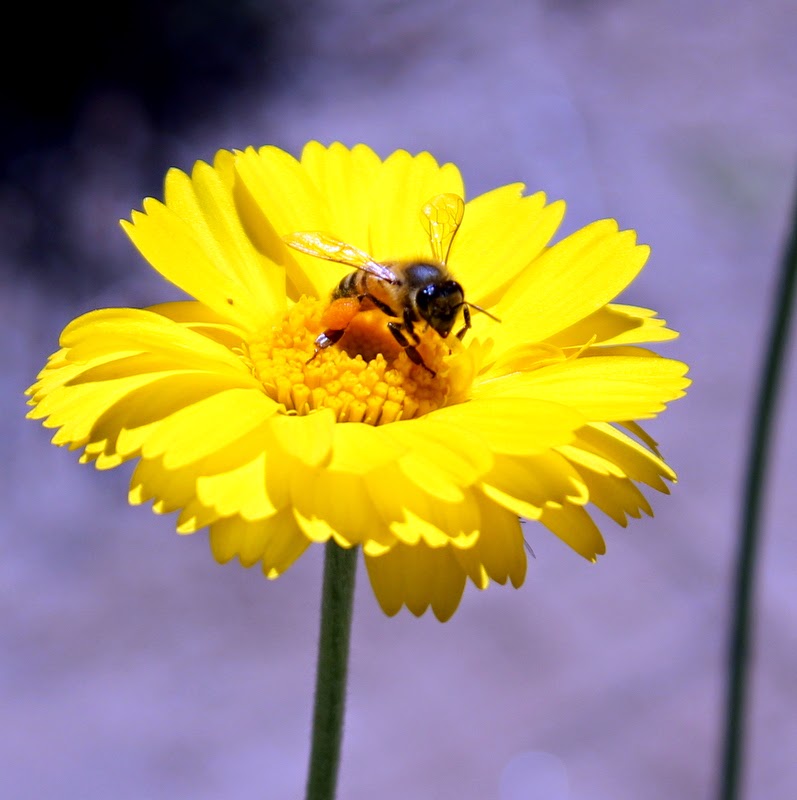 |
| another wildflower close-up |
In the early years of the 20th century Thompson had much success on Wall Street and was involved in many different endeavors including philanthropy and humanitarian causes, politics, being a political envoy to different countries including Peru and Russia, and working with the Red Cross. After World War I, he decided he disliked politics and devoted more time to the winter home (Picket Post House) he was building in the hills near Superior, AZ. He originally didn't even own any of the land where he was building his winter home; the Forest Service owned it as part of the Crook National Forest. He had to get a special permit from them just to build the house.
 |
| a winter visitor I was really excited to see- a male Hooded Merganser duck. Not the best photo, but he seemed kind of shy so this was actually pretty good. (thank goodness for the long camera lens!) |
Apparently he used some of his Wall-Street deal-making abilities with the Forest Service, though, and in exchange for him buying and giving them some land they wanted in Northern AZ, they gave him ownership of 400 acres of the National Forest around the house he was building. He chose someone from the University of Arizona to establish the Boyce Thompson Southwest Arboretum on a portion of the 400 acres; its mission was to study the plants of desert countries and make the results available to the public.
 |
| a small lizard, warming himself in the spring sunlight. He's actually quite colorful, as is the lichen-encrusted rock he's sitting on. |
One of his philanthropic endeavors back in NY was also plant research, to study plant physiology with the goal of ensuring a stable food supply for the growing US population. He had developed an interest in plants after his Red Cross visits to Russia during WWI, where he came to understand how important plants are for humans as a source of food, clothing, and shelter. Apparently his original Institute for Plant Research site- which was across the road from his NY estate- is abandoned also; see the story here with more photos. (kind of creepy, actually.) FYI, the Institute is still functioning, and today is housed on the campus of Cornell University.
 |
| fruit tree blooms of some sort. Not sure what kind of tree it is, but the salmon-pink color is gorgeous! |
In one part of the arboretum, there is a very old stone cottage that's tucked right up next to a vertical cliff face (the cliff wall actually forms one wall of the cottage). This cottage was lived in years before Colonel Thompson bought the property, and its grounds contain planting beds including an herb garden, roses, and a small orchard area. (unfortunately I don't know my fruit trees either- without the fruit on, lol- and didn't think to look for tags on the trees.)
 |
| a view of the Queen Creek from a small suspension bridge that crosses it. Picket Post House isn't visible in this photo, but it's on top of that ridge, right above / behind that bright green tree. |
The Arboretum is Arizona's oldest and largest (at 323 acres) botanical garden, was the first purely botanical institution in the inter-mountain states, and is the fourth oldest botanical garden west of the Mississippi River. It houses over 600 kinds of cacti as well as rare and endangered plants from around the world totaling more than 2,600 species altogether. It is an Arizona State Park, a National Historic Site, and in conjunction with the University of Arizona, a scientific research facility. It's a very beautiful- and picturesque- place to visit, and well worth the drive. (It's about an hour's drive from Phoenix, and just under two hours from Tucson.)
 |
| a bee, quite intent on loading up his pollen baskets. They really don't pay any attention to me at all as I'm taking pictures; they're too focused on the task at hand (so to speak, lol). |
Sorry this post got sort of long; I started out with random photos then went down a bit of a rabbit hole, looking up the history of the Arboretum. I hope it was interesting, though- it was really interesting to research!
This blog post was made possible with information from the Arboretum's History Page, (here), the William Boyce Thompson page from the Yonkers Historical Society website (here), and the Wikipedia entry for the Arboretum (here) as well as various other websites including the AZ National Parks page.
3 comments:
Thank you for the history lesson - I love stuff like this!
Your photos - as always - are beautiful.
Have a great rest of the week!
beautiful photos, Jenn!
These are just beautiful! looks like a wonderful place to visit.
Thanks for visiting my blog earlier this month. For some reason, your comment is not showing up on the blog post, I can only see it on the dashboard. Blogger has so many goofs!
I love to mix papers and DCWV stacks lend well to mixing and layering.
Post a Comment